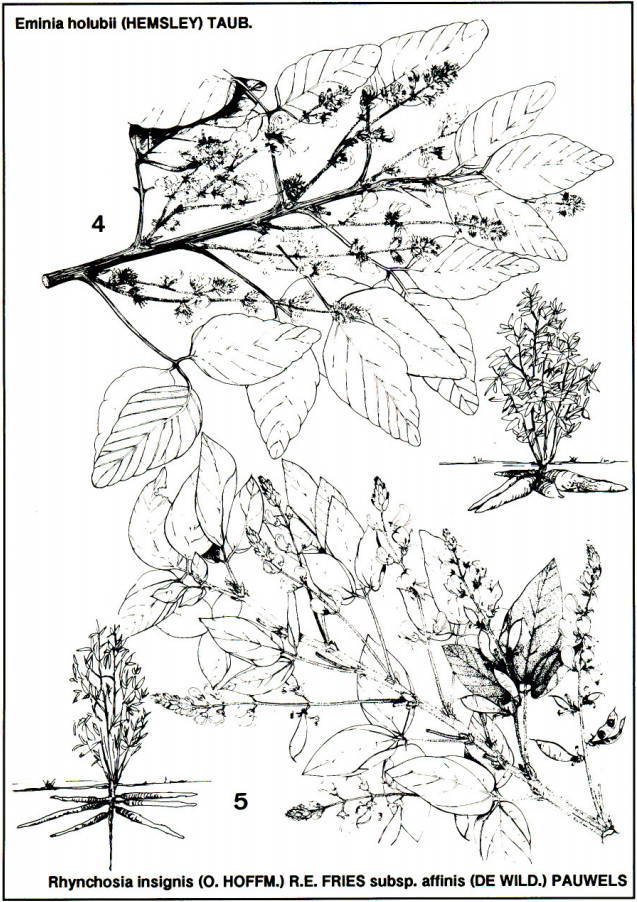|
Pathway no. 4 : PLANTS WITH AMYLOLYTIC COMPLEX |
|
In some parts of Africa, the mash (cooked porridge made from sorghum, maize or cassava flour) for brewing traditional beers is hydrolysed by dipping plants directly into the cooled mass. The enzyme source is therefore exogenous. This time it is no longer mycelium but roots or bulbs that can produce and fix enzymes of the amylase class.
On the borders between Zaire and Zambia, the inhabitants exploit the dried root amylases of a shrub (Eminia holubii Taub) or the species Rhynchosia insignis and Vigna nuda. Cassava plants and beers are gathered there under the name Munkoyo (a vernacular name for the plants belonging to Eminia genus)[1]. In West Africa, extracts of Curculigo pilosa, bulbs of Gladiolus klattianus or leaves of Boscia senegalensis naturally store saccharifying enzymes.
As with malt (pathway n° 2) and amylolytic ferments (pathway n° 3), roots and bulbs < em>Munkoyo are traded locally. The plants are collected in the forest, dried, carried and sold to the women brewers in the villages. The harvesters have a perfect knowledge of the plant environment, which implies a know-how passed down over many years.
See the studies on Munkoyo and Dany Griffon's PhD about the munkoyu beer in République du Congo and Zambia (doc in french).
The comparison of the proportions of amylases α and β contained in barley malt and the roots of Eminia, Vigna and Rhynchosia explains the extraordinary saccharifying activity of the so-called Munkoyo plants. All varieties of Rhynchosia and Fabaceae related to Eminia do not have the same diastasic power. Rhynchosia insignis comes first. |
|
Some plants have saccharifying enzymes in their roots or aerial organs: roots of the genera Eminia, or Rhynchosia, stems of the liana Abrus pulchellus, leaves of Boscia senegalensis, etc.
The brewing process consists of macerating these plants in a slurry of raw (non-malted) grains. Enzymes hydrolyse the cooked starch. The mash becomes liquid, sweet and fermentable.
This method is quite similar to malting. The origin of the saccharifying enzymes is endogenous (sprouted grains) for malting. Here it is exogenous. This method is therefore suitable for all sources of starch: grains but also tubers, starchy fruits or bulbs, starchy pith. |
|
This brewing method is an indigenous African technique. Two geographical foci have been identified to date: Upper Congo and Zambia on one side, and Senegal on the other. Two foci, two very different geographical areas, more than 5000 km apart. Zambia is close to the Songola (Upper Congo Basin), who have mastered another brewing method, pathway No 3 of mycelium cultivation for brewing purposes. It is almost impossible that an influence from outside Africa could have taught these sophisticated techniques to the people concerned in an isolated forest region. East Africa has been in contact with Asia (Near East, India, China occasionally) for 2000 years. But influences and exchanges remained limited to the coastal areas, even after the expansion of the Swahili culture and the slave raids in the depths of the African continent. There is said to be a conservatory of African brewing techniques straddling Upper Congo and Zambia. This indigenous know-how owes nothing to the malting techniques (way No 2) common to East and West Africa of the savannahs and cereal river basins (Senegal, Niger, Volta). Nor does it owe anything to colonial policies (Portuguese colonisation of Mozambique around 1550) that have most often ignored and fought against traditional beer making in Africa. This article sums up the studies of two traditional Senegalese millet beers brewed by the Joola and the Seerer.
This indigenous African tradition exists in Senegal, almost 5000 km away from central Congo. Boumkaye and Niéniébane millet beers are brewed with Abrus pulchellus lianas or the stems and leaves of Boscia senegalensis, following the same principle as Munkoyo beer. This brewing method probably exists elsewhere in Africa, waiting to be described by researchers in the field.
|
[1] In the Katanga province in the Democratic Republic of Congo, and in Zambia, people use the roots of certain Fabaceae in the brewing of the traditional "Munkoyo" beer. Six taxa are known for their amylolytic properties: Eminia holubii (Hemsley) Taub., E. harmsiana De Wild., E. antennulifera (Baker) Taub., Rhynchosia insignis (Hoffm.) R. E. Fries subsp. insignis, Rhynchosia insignis (Hoffm.) R. E. Fries subsp. affinis (De Wild.) Pauwels and Vigna nuda N. E. Br http://www.nzenzeflowerspauwels.be/REFERENCES.htm and a pdf document which describes the making of munkoyo beer (in French)
FABRICATION DE LA BIÈRE «MUNKOYO» (website stayed in http => eventuel securtiy warning when downloading the file )







-EN.png)